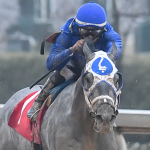
Preakness Quick Sheet: Get to Know the 2021 Preakness Horses

With another Breeders’ Cup in the books, there’s no shortage of could haves, would haves, and should haves. So for the next few weeks, let’s look back at what happened on Nov. 1-2 during the 36th edition of the World Championships to see what lessons can be gleaned from it.
For one, how was your money management? Ideally, every handicapper dreams of striking it big early in the card and then playing with house money the rest of the way.
Unfortunately, it usually doesn’t work out that way.

By the time the Longines Turf and Longines Classic rolled around to close out the event, many a gambler no doubt saw moths flying out of an empty spot in their wallet where there used to be a wad of cash and felt punch drunk from a series of bad beats, reducing them to making wild bets in a futile bid to get back in the black.
And, of course, at that moment when your wallet has just about hit empty that’s when it’s post time for your best bets of the day and you only have a pittance to bet on them.
That’s what’s known as bad money management and it’s easily avoidable.
At an event like the Breeders’ Cup, where the pre-entries give you a good preview of the field 10 days or so before the race, there’s no reason for not having a battle plan in place. Whether it works or not is a different matter, but you should be organized with a plan of attack in place to make optimal use of all these hours you spent handicapping.
You should strive to lock in at least a few wagers at the start of the day, especially if you like races at the end of the card. This way, taking it on the chin in the Maker's Mark Filly and Mare Turf when you backed the wrong longshot does not leave you with a greatly diminished bankroll and a shell-shocked feeling.
This way, when your head is clear and you are quite optimistic – and you have a healthy stack of cash or a lofty amount in your wagering account – you can give yourself a realistic chance at making a profit instead of wildly swinging for the fences as you play catch-up.
Best of all, the last few races are usually fairly chalky, giving $2 bettors a chance to bounce back with a smart and focused wager as opposed to hitching their financial wagon to a hopelessly overmatched 40-1 shot.
And even with modest-priced horses, handicappers who pick the right horses in a Breeders’ Cup race can expect to be rewarded at a much kinder rate than most days at the track.
For example, in the Classic, let’s say you liked the three favorites, McKinzie, Code of Honor, and Vino Rosso. By boxing them in the $2 exacta, you invested $12 but got back $47.60 when third choice Vino Rosso ($11.20) beat the 5-2 favorite McKinzie.
Think about that. Third-choice over the favorite and it pays $47.60 in the exacta. That’s value and evidence of why, even though so many 20-1 shots are alluring at the Breeders’ Cup, there’s also something to be said about liking some modestly priced horses and making a strong bet on them as well.
The late double was bland. Combining Bricks and Mortar ($4) with Vino Rosso was worth $25.60, which was barely above the parlay of the two win prices ($22.40).
The final Pick 3, however, had a nice payoff, courtesy of two beaten favorites. Adding in Blue Prize ($19.80), the third choice in the Longines Distaff, the Pick 3 came back paying $377.60. To better understand the value in that price, it combined a third choice with a favorite with a third choice. So if you bought a 3 x 3 x 3 ticket for $54 (giving you some margin for error), you cleared $323.60, and if you singled Bricks and Mortar and took a 4 x 1 x 4 ticket for $32, you made $345.60.
Again, if you were wishy-washy about the last few races, that’s fine.
The key to a couple of great days like the Breeders’ Cup is picking out the races you like best and taking your swing with them.
This way, whether you hit a home run or go down swinging, at least you can walk away knowing you took your best shot at making a bundle.